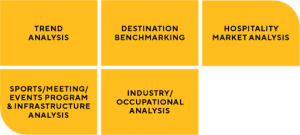
About the Plan
Introduction
Tourism is a powerful force in the growth and development of the regional economy, developing employment opportunities for residents and driving community improvements. The Tourism Development Plan places a greater emphasis on ensuring tourism delivers even stronger benefits to the community as it works towards increasing total economic impact to both the City of Pittsburgh and Allegheny County. The development of tourism across all neighborhoods is vital to improving and growing the visitor experience while supporting the overall quality of life for Pittsburghers.
The Tourism Development Plan provides a roadmap for the management and marketing of tourism in the destination moving forward by VisitPittsburgh and partners based on an assessment of tourism assets and experiences, target audiences, and community aspirations. Today, culinary experiences, sightseeing, outdoor activities, and museums are key competitive advantages. Sports continue to shape Pittsburgh’s identity as a destination. Outdoor activities represent a development opportunity to meet growing consumer demand for visitors to further enjoy the city’s riverfront and extensive trail network systems. Pittsburgh’s rich cultural heritage and institutions are key assets to develop and market in order to attract new audiences. Overall perceptions of Pittsburgh by both visitors and residents are positive – it’s perceived mainly as fun and welcoming, historical and authentic, and beautiful. Most visitors have a good perception of Pittsburgh as a place to visit, and residents also recognize the importance of tourism to the local economy and agree that the industry positively impacts the community’s quality of life.
The future brings enormous opportunities for the development of tourism in the City of Pittsburgh and Allegheny County.
Project Background
In the summer of 2022, VisitPittsburgh embarked on the development of a Tourism Development Plan to identify priorities over the next decade that would enable the City and Allegheny County to deliver a positive visitor experience while enhancing the quality of life for local residents and workers.
Resonance Consultancy and partner HVS (‘the project team’) were engaged to carry out industry and trends research, destination benchmarking, and stakeholder engagement in order to inform the creation of the tourism development plan. This approach was specifically designed to help VisitPITTSBURGH, the City of Pittsburgh, Allegheny County, and various industry and community-based organizations articulate and share a clear vision for the future.
One of the main goals for this tourism development planning effort was to ensure an inclusive roadmap is built for the tourism and hospitality industry by its major players and stakeholders.

The findings from this phase are summarized in a comprehensive Situational Analysis report (see Appendix). The report outlines the current state of tourism in Pittsburgh and Allegheny County, its strengths and weaknesses as a destination based on current market trends, and the key opportunities and issues that should be addressed in the Pittsburgh Tourism Development Plan.
In this first phase, the project team conducted a mix of quantitative and qualitative research and laid the groundwork for stakeholder engagement.
Based on insights gleaned in Phases 1-2, the project team developed a vision and recommendations that will guide the development, management, and marketing of tourism and events across Allegheny County for the next 10 years.
Key to the success of any strategic planning initiative is the corresponding implementation and action plan that defines responsibilities, timelines, and priorities for the implementation of the recommendations.

Vision
Pittsburgh welcomes the world to enjoy a neighborly, unconventional, and unfiltered experience. With more than 90 unique neighborhoods – and 446 bridges – Pittsburgh is a city of multitudes. Diversity and acceptance is who we are.
Beyond the City, Allegheny County’s mountains, rivers, and parks are a unique playground for active adventurers year-round, while urban enthusiasts gather to celebrate legendary sports teams, enjoy local crafts, and diverse arts and culture. The region’s long history of innovation is a model to other destinations – from glass to steel, and life sciences to robotics – attracting future-focused events and innovative businesses.
In Pittsburgh, expect the unexpected, experience multitudes.
Audience Segments
A key approach to the development of this Tourism Development Plan was to identify and analyze the perceptions, needs, and interests of local residents, regional and drive-market visitors, and overnight business and leisure travelers in order to understand who visits Pittsburgh and why. These comprise a combination of current and aspirational demographics and psychographics. By looking at Pittsburgh from the perspective of these audiences, strategies and actions were then identified to cater to the needs and interests of these specific groups. This market-driven approach provides focus to the planning process and will also help inform future marketing efforts as well. Understanding how the local community wants Pittsburgh to be positioned and developed as a live-, work-, and play destination is critical to the success of the Tourism Development Plan.
Local Allegheny County residents are a mix of established GenX urbanites with moderate incomes and young families, and single city renters at the beginning of their careers.
By necessity, regional commuters, and workers are the most frequent visitors to Pittsburgh. This workforce has moderate earnings and is predominantly employed in the healthcare and social services and services sector, and in office/administrative roles.
Drive market visitors living within a 3-5 hour driveof Pittsburgh are a mix of major metropolitan city dwellers and mid-tier to affluent suburban families just outside major markets such as Cleveland and Columbus.
Fly market visitors include travelers from outside the drive market and reaching as far as international audiences. They comprise both leisure and business travelers who arrive in Pittsburgh primarily by plane.